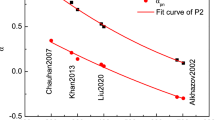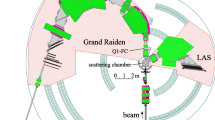Abstract
Inelastic scattering of α-particles can excite the isovector giant dipole resonance (GDR) via the Coulomb interaction. In spite of their isoscalar nature α-particles can also excite the GDR via the nuclear interaction due to the difference in the radii of the neutron and proton density distributions. The absolute cross section to excite the GDR in inelastic α-scattering is therefore a measure of this radial difference, the so-called neutron-skin thickness. Furthermore, since the GDR strength distribution has a centroid energy which depends on the nuclear radius, these studies, when performed in deformed nuclei, can measure the neutron-skin thickness along both the short and the long axes independently. Results of an experiment performed at KVI atE α=120 MeV and small scattering angles, including 0°, to determine the neutron-skin thickness in208Pb,116Sn,124Sn, and the deformed150Nd are discussed and compared to earlier measurements and theoretical predictions. Future improvements in the experimental set-up are also discussed.
Similar content being viewed by others
References
H. de Vries, C.W. de Jager and C. de Vries,At. Data Nucl. Data Tables 36 (1987) 495.
C.J. Batty et al.,Adv. Nucl. Phys. 19 (1989) 1.
L. Ray,Phys. Rev. C41 (1990) 2816.
L. Ray and G.W. Hoffmann,Phys. Rev. C31 (1985) 538.
J.J. Kelly,Phys. Rev. C37 (1988) 520.
J.J. Kelly et al.,Phys. Rev. C44 (1991) 1963.
M.A. Khandaker et al.,Phys. Rev. C44 (1991) 1978.
J.M. Knudson et al.,Phys. Rev. Lett. 66 (1991) 1026.
A. Krasznahorkay et al.,Phys. Rev. Lett. 66 (1991) 1287.
A. Krasznahorkay et al.,Nucl. Phys. A567 (1994) 521.
G.R. Satchler,Nucl. Phys. A472 (1987) 215.
T.D. Poelhekken et al.,Phys. Rev. Lett. 62 (1989) 16.
A.G. Drentje, H.A. Enge and S.B. Kowalski,Nucl. Instr. Meth. 122 (1974) 485.
S. Brandenburg et al.,Nucl. Phys. A466 (1987) 29.
H. Hofmann et al.,KVI Annual Report (1985) p. 110.
S.D. Hoblit and A.M. Nathan,Phys. Rev. C44 (1991) 2372.
W.D. Myers et al.,Phys. Rev. C15 (1977) 2032.
J. Raynal, Coupled-Channel Computer Code ECIS, private communication.
I. Brissaud et al.,Phys. Rev. C6 (1972) 585.
M. Nolte, H. Machner and J. Bojowald,Phys. Rev. C36 (1987) 1312.
P.A. Goldberg et al.,Phys. Rev. C7 (1973) 1938.
F. Pühlhofer,Nucl. Phys. A280 (1977) 267; M.N. Harakeh, computer code CASCADE, extended version.
R.D. Starr, P. Axel and L.S. Cardman,Phys. Rev. C25 (1982) 780.
I. Angeli et al.,J. Phys. G 6 (1980) 303.
J. Dechargé and D. Gogny,Phys. Rev. C21 (1980) 1568.
J. Bartel and M.B. Johnson,Ann. Phys. (N.Y.) 195 (1989) 89.
A. Krasznahorkay et al.,Nucl. Instr. Meth. A316 (1992) 306.
Author information
Authors and Affiliations
Rights and permissions
About this article
Cite this article
Harakeh, M.N., Krasznahorkay, A. GDR excitation by isoscalar probes: a means to determine the neutron-skin thickness. APH N.S., Heavy Ion Physics 6, 1–12 (1997). https://doi.org/10.1007/BF03158477
Received:
Issue Date:
DOI: https://doi.org/10.1007/BF03158477




